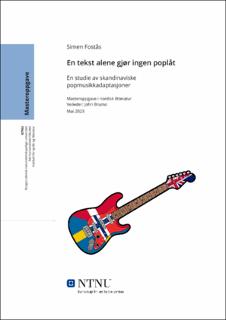En tekst alene gjør ingen poplåt
Master thesis

Permanent lenke
https://hdl.handle.net/11250/3074821Utgivelsesdato
2023Metadata
Vis full innførselSamlinger
Sammendrag
Denne avhandlingen tar for seg to låter som opphav og tre adaptasjoner av hver av disse innenfor populærmusikken i Skandinavia mellom omtrent 1955 og 1999. Det presenteres relevant kontekst og teori, samt analyser av de opprinnelige låtene og av hver av adaptasjonene. Det presenteres to låter på hvert av språkene engelsk, norsk, svensk og dansk, og i tillegg til litteraturvitenskapen, opptrer også innslag av musikkvitenskap, fordi tekstene er del av et større produkt. Det diskuteres blant annet originalitet og autentisitet.
Resultatene av disse undersøkelsene viser at man i mange, men ikke alle, tilfeller kan finne sammenfall i oppbygning og form, selv om det semantiske er ulikt. Vi ser også at populærmusikk i mange tilfeller har et nesten konsekvent gjennomgående tema (kjærlighet), men at de relasjonene som finnes i tekstene er varierte.
Låtene som analyseres i denne avhandlingen er:
• Love Grows (Where My Rosemary Goes) – Edison Lighthouse (GB)
• Solskinn inni Blådressen min – Vazelina Bilopphøggers (no.)
• Sån är min värld – Jigs (se.)
• Han er herlig – Ulla Pia (dk.)
• The Wanderer – Dion (USA)
• Kung I Stan – Arvingarna (se.)
• På Vål’enga – Vazelina Bilopphøggers (no.)
• Volleborg – Bamses Venner (dk.) This thesis deals with two songs as origins and three adaptations of each of these within popular music in Scandinavia between approximately 1955 and 1999. Relevant context and theory are presented, as well as readings of the two original songs and each of the adaptations. Two songs are presented in each of the languages English, Norwegian, Swedish and Danish, and in addition to literature, elements of musicology also appear, because the lyrics are part of a larger product. Among other things, originality and authenticity are discussed.
The results of this research show that in many, but not all cases coincidences in structure and form can be found, even if the semantics are different. We also see that popular music in many cases has an almost consistently consistent theme (love), but that the relationships found in the lyrics are varied.
The songs analyzed in this thesis are:
• Love Grows (Where My Rosemary Goes) – Edison Lighthouse (GB)
• Solskinn inni Blådressen min – Vazelina Bilopphøggers (no.)
• Sån är min värld – Jigs (se.)
• Han er herlig – Ulla Pia (dk.)
• The Wanderer – Dion (USA)
• Kung I Stan – Arvingarna (se.)
• På Vål’enga – Vazelina Bilopphøggers (no.)
• Volleborg – Bamses Venner (dk.)